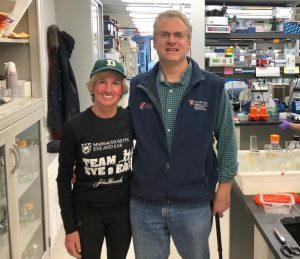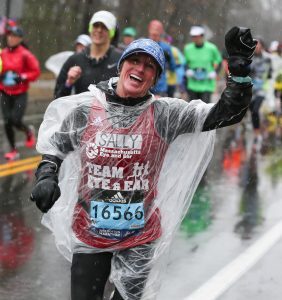On April 15, Sally Ankeny Reiley will run her sixth Boston Marathon® as a member of Team Eye and Ear, Mass. Eye and Ear’s marathon team. A long-time Trustee of the hospital, she runs to raise money for vision research that will lead to new treatments and cures for blinding eye diseases. Recently, Sally sat down with Eric Pierce, MD, PhD, director of the Ocular Genomics Institute at Mass. Eye and Ear and fellow alum from Dartmouth College Class of 1981, to talk about his work. In this guest post on Focus, Sally describes Eric’s life-changing research to better diagnose and treat inherited forms of blindness and how it strengthens her commitment to Mass. Eye and Ear’s mission.
Making medical history
When I met Eric in his office this past February, I was excited to hear about his research. As we got to talking, it very quickly became clear just how much he has accomplished since I began running for Team Eye and Ear.
Perhaps Eric’s most momentous and buzz worthy achievement took place just last year when he was part of the team that made history by performing the first post-FDA-approved gene therapy for patients with a form of inherited blindness. The treatment, commercially identified as Luxturna™ and developed by Spark Therapeutics, was given to a 13-year-old patient named Jack who was born with an inherited retinal disorder called retinitis pigmentosa. Eric was involved in the gene therapy’s early testing. His track record of leadership and expertise in ocular genomics was integral to Mass. Eye and Ear being chosen as the administration site for the treatment. Just two months after surgery, Jack’s vision was markedly improved. For more on his incredible story, check out this video.
This groundbreaking surgery marks the beginning of a new era in medicine as it paves the way for future gene therapy treatments that will save and restore vision for many more people. Luxturna™ has since been given to three more patients at Mass. Eye and Ear, and Eric and his team are conducting human trials to test potential therapies for eight other genetic forms of inherited retinal disease. Five years ago, there were no clinical trials of gene therapies at Mass Eye and Ear. None.

Advancing the mission to eradicate blindness
Eric attributes this remarkable progress to several factors.
The first is the incredible advances being made in the field of gene therapy. To date, more than 260 disease-causing genes associated with inherited retinal disorders have been found. We can now identify the genetic cause of disease for two-thirds of patients through genetic testing.
Researchers are also developing novel ways of treating genetic diseases, primarily through gene therapy or gene editing. Gene therapy, in which a defective gene is replaced with a synthetic healthy copy, is the modality that successfully treated Jack and is being evaluated in other human trials at Mass. Eye and Ear. Gene editing involves fixing a mutated gene using CRISPR/Cas9-based technologies. Under Eric’s leadership, Mass. Eye and Ear will soon participate in the first-in-human study of CRISPR/Cas9-based gene editing for a severe, early onset form of inherited blindness called Leber congenital amaurosis using a treatment developed by Editas Medicine.
Industry partnerships like this are another reason Eric believes the field has progressed so rapidly. Each of the eight gene therapy human trials currently underway at Mass. Eye and Ear is being sponsored by a pharmaceutical or biotech company. These collaborations provide essential resources to get these trials off the ground, without which we would not be able to offer effective therapies to patients in need.
Just the beginning
With so much success under his belt, I asked Eric what his biggest goals are going forward. He said that despite the tremendous progress in the field, there are still many people living with inherited forms of blindness for whom genetic therapies have yet to be developed. His ultimate goal is to provide a gene or genetic therapy for everyone with an inherited form of blindness.
“We are starting to succeed with our mission,” said Eric. “What’s both exciting and challenging is that this is just the beginning.”

Running for cures
For most of my life, running a marathon was NEVER on my bucket list. But in 2014, I felt compelled to run after the horrific Boston Marathon® bombings the year before. My goal was simply to finish the 26.2 miles and enjoy the experience. But as I got to know the other runners and hear their inspiring stories, it became about much more than that.
I developed a greater appreciation of what an amazing place Mass. Eye and Ear is and how much it means to so many people. I also more fully understood the challenges faced by clinician-scientists and patients alike and the importance of philanthropy in giving them the support they need.
That first year, I was scared to commit to the $10,000 minimum fundraising requirement, but managed to reach $34,000. To date, I have raised more than $175,000 and aim to surpass $200,000 this year.
As I prepare to run my sixth Boston Marathon® on April 15, I am honored to play a small role in helping Eric advance his important work and provide hope to people living with blinding eye diseases.
To learn how you can support Sally and her teammates on Marathon Monday, please visit Sally’s or Team Eye and Ear’s fundraising pages on Crowdrise.